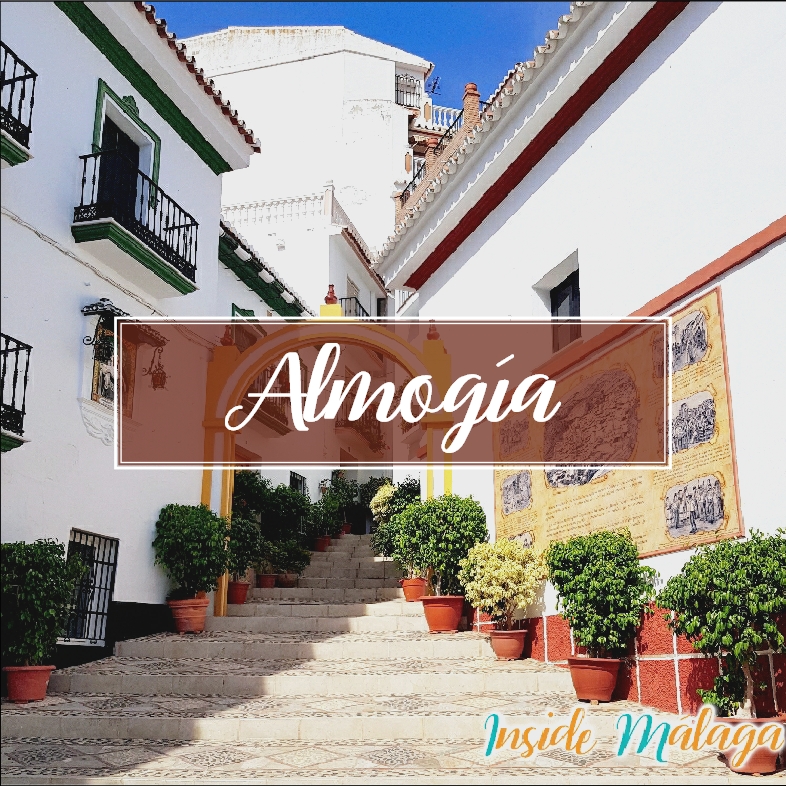Almogía, a relaxing walk through its streets full of flowers and its views over the mountains of Malaga that should be compulsory therapy for anyone.
Where is Almogía located
Almogía is located in the interior of the province Málaga, 25km from Málaga capital with a population of 3.770 inhabitants. The town is situated in the Guadalhorce Valley close to the Montes de Málaga.
The origin of the name Almogía
Possibly it origins from Andalusian Arabic and Hispanic romance word Al-Mexia, there is no exactness of the origin of the name, but there are two theories:
- Derivation of the name of a Berber tribe named “Al-Mexi”.
- A linguistic translation of the term “The beautiful”.
Denonym of the people of Almogía
The inhabitants are called “almogiense“.
Where to park in Almogía
Once close and entering the village we observe that there are not many parking lots, before we entered the village we saw some parking slots, but we got inside the town with the car through the narrow and sloping streets. We found a parking place on a hill, although I highly recommend parking on the outskirts of the village.
Curiosities about Almogía
Almogía village is one of the most important when it comes to Verdiales folklore.
Monuments and places of interest in Almogía
- Castle of Almogía <Torre de la Vela>: Remains and ruins of the Arab castle that served from 1410 to 1487 as a border fortress. Only the Torre de Vela remains, the only one of seven towers that formed the castle.
- Church of Nuestra Señora de la Asunción: Located on Calle Iglesia, built on an old mosque in the 16th century (1552) by the architect Diego de Vergara. The church was rebuilt in 1891 after an earthquake.
- Hermitage of Sagrado Corazón de Jesús: From the 17th century it was part of the old asylum convent of the Sacred Heart.
- Hermitage of the Tres Cruces: It is a small hermitage from the 17th-18th century, restored some years ago, where the Verdiales festival of the first of May is celebrated. It is located in the limits of the municipalities of Almogía, Cártama and Álora, also near Pizarra it is here where the processions of the four towns are located in the “Cruces de Mayo” where several pandas of verdiales are celebrated. Inside each town has a small altar.
- Lavadero La Nora: Built in the 19th century and used until 1990, it consists of about thirty earthenware basins with wash stones located around a pound.
- Chapel of Santo Cristo: The original chapel was built in the 17th century to house the image of the Crucified Holy Christ. The small temple underwent quite a major remodeling in the 19th century.
- Capilla de Santa Ana: Located on Calle San Antonio, the chapel was built by the Moreno Campos family in honor of the Virgin Santa Ana in the historic center of the town.
- Fountain of Hortezuela: Located on Calle Hortezuela, the fountain built in the 19th century. Formed in 3 parts with 3 pylons and with a total of five pipes. In the middle part there is a mosaic that represents the town in the Middle Ages.
History of Almogía
The human presence in the Almogía area dates back to prehistoric times where cave paintings have been found in some caves in the area. Along with some remains of Roman vestiges, remains of the pre-Roman Turdetana people from the 5th to 2nd century BC have been found. In Roman times Almogía was a strategic point since it has the remains of a Roman road.
In the Muslim era is when a population nucleus settled around the Castle of Almogía is created, of which only the Torre de Vela currently remains, which was important during the revolt of Omar ben Hafsún against the Cordovan emirate that played a fundamental role in defense from that town called Bobastro. The castle and its surroundings formed the second defensive belt of the city and fortress of Bobastro
The town was handed over in 1487 by the Moors to Queen Isabel La Catolica. The Inquisition was very established and carrying out inspections in this region due to the large presence of Moriscos. The Moors (Muslims from Al-Andalus baptized to Christianity) participated in the rebellion of the Alpujarras of 1568-1570 against the Spanish monarchy, once defeated they were expelled to the interior of the country. The unpopulated lands were repopulated with a Christian population from the towns of Teba and Antequera.
In 1564, the Council of Almogía loaned the bell from the Vela tower of its castle to the Cathedral of Malaga to be installed in this Cathedral Church.
During the War of Independence (1808-1814) against Napoleonic France, Almogía and its castle were invaded by Napoleonic troops who destroyed the entire castle in their retreat.
Festivities in Almogía
- Carnaval
- Semana Santa
- Festival de los Verdiales: Beginning of August
- Feria de Agosto: In honor of San Roque y San Sebastián
- Mayo: Romería de San Isidro Labrador
- Día de la almendra: Day of the Almond, every last Sunday of September there is a festive dedicated to the great almond tradition in Andalusia (Spain is the third largest producer in the world). This local festival in the Almogía village, celebrates and shows the great tradition of growing this dried fruit, the local bars and restaurants serve enriched dishes such as chicken, meatballs or snails in almond sauce. The festivities are also held at the main square with tastings of local dishes and decorated with market stalls that offer local and traditional products. The festivities are accompanied by verdial chant folk music of the local choir.
For more information about Almogía Village: visit the City Council page
